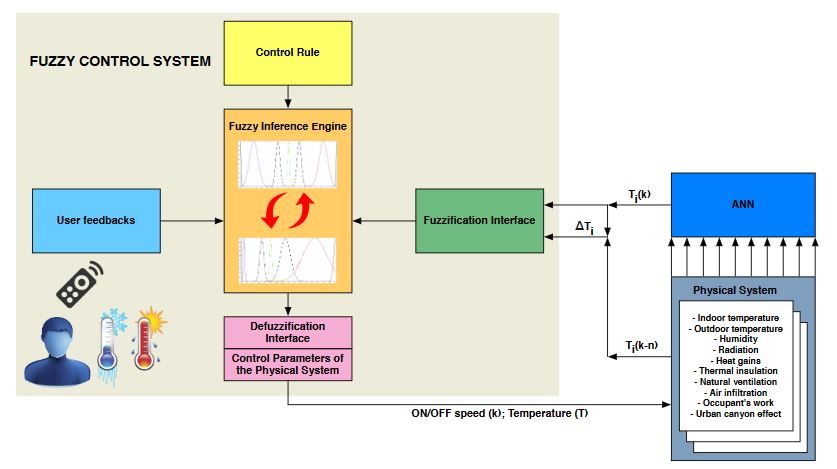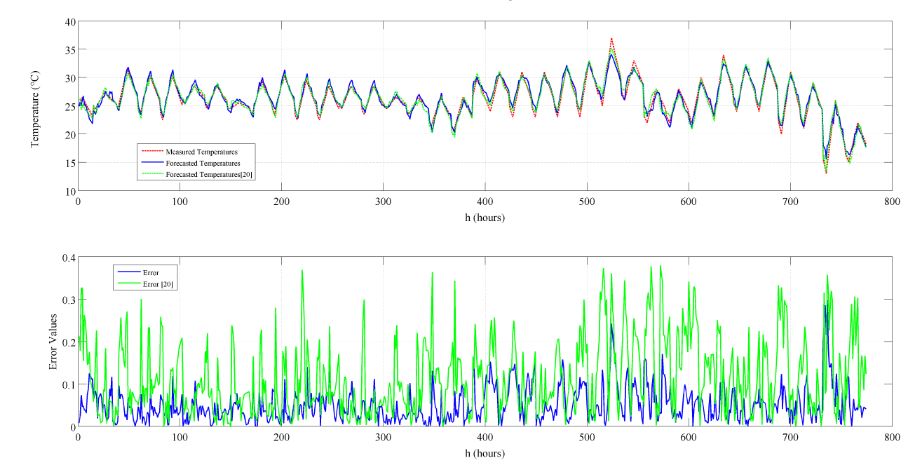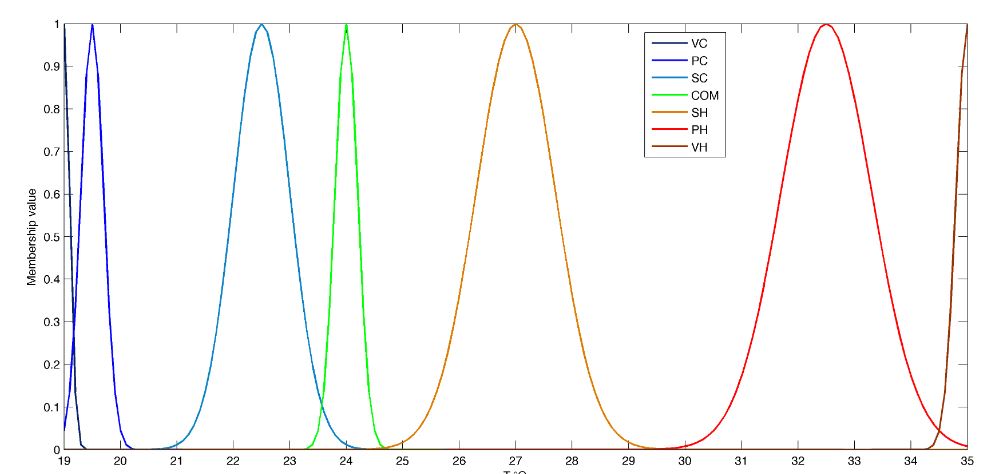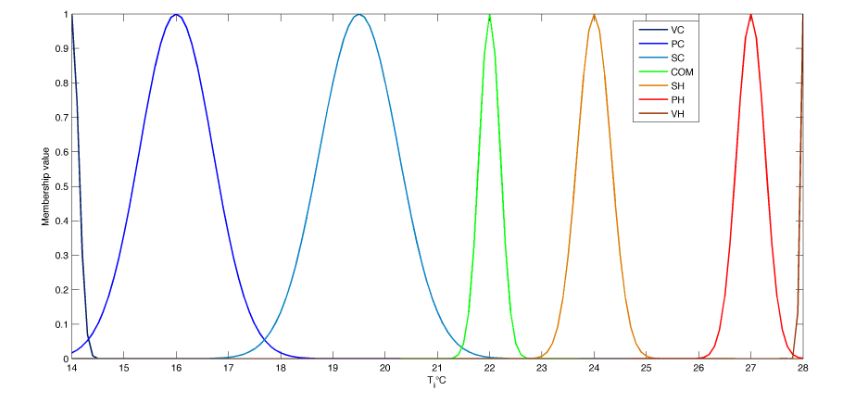ABSTRACT
Heating, ventilating and air-conditioning (HVAC) systems are typical non-linear time-variable multivariate systems with disturbances and uncertainties. In this paper, an approach based on a combined neuro-fuzzy model for dynamic and automatic regulation of indoor temperature is proposed. The proposed artificial neural network performs indoor temperatures forecasts that are used to feed a fuzzy logic control unit in order to manage the on/off switching of the HVAC system and the regulation of the inlet air speed.
Moreover, the used neural network is optimized by the analytical calculation of the embedding parameters, and the goodness of this approach is tested through MATLAB. The fuzzy controller is driven by the indoor temperature forecasted by the neural network module and is able to adjust the membership functions dynamically, since thermal comfort is a very subjective factor and may vary even in the same subject.
The paper shows some experimental results, through a real implementation in an embedded prototyping board, of the proposed approach in terms of the evolution of the inlet air speed injected by the fan coils, the indoor air temperature forecasted by the neural network model and the adjusting of the membership functions after receiving user feedback.
STATE-OF-THE-ART
Air temperature control inside buildings is not easy, if the purpose is the maintaining of thermal comfort conditions. The thermostat is a device used to regulate the indoor temperature parameters. It is low cost and reusable. However, considering its very reduced functionalities, it is not suitable in order to meet some typical requirements, with the purpose of obtaining improved comfort parameters. Moreover, it is necessary to consider the increasing of the power consumption, due to the setting choices of the users inside the building. Therefore, it is necessary to develop smart strategies for thermal control in order to obtain internal comfort automatically.
SYSTEM MODEL

Figure 1. System architecture
The proposed system is characterized by the architecture depicted in Figure 1. The main elements of the system are an artificial neural network (ANN) and a fuzzy logic controller (FLC), described in detail in Section 4 and Section 5 of this work, respectively. In the proposed approach, the effect of weather parameters are taken into account in order to train an ANN model aiming at forecasting indoor temperature. The output of the ANN is used to feed an FLC, which has the goal of keeping acceptable indoor conditions from the thermal comfort point of view.
FORECASTED TEMPERATURE BY USING AN ANN MODEL

Figure 3. Measures of forecasting indoor temperatures (top) and forecasting error (down)
Figure 3 refers to the summer one. In both scenarios, the temperature values are the ones recorded when the HVAC system is off, i.e., they refer to the building envelope in natural evolution dynamics. The approach proposed in this paper obtains a lower error (an average of about 0.2 degrees Celsius lower) compared to the one proposed by Marvuglia et al, using both a lower number of inputs and a higher number of neurons. This is not a problem, since, as shown, the complexity of the system is not directly proportional to the number of used neurons.
FUZZY CONTROL SYSTEM

Figure 5. Membership functions for T i in the summer scenario
Figures 5, 6 and 7, respectively. The aim of the controller is to elaborate on these linguistic values using an inference mechanism based on a set of if-then rules. These rules are combined in the FLC, which returns a membership function, represented, in this paper, by Gaussian functional shapes.
EXPERIMENTAL RESULTS

Figure 10. Adjusted membership functions for T i in the summer scenario
As mentioned previously, the user can provide feedback on the temperature of the environment. In order to do this, the current membership function is displayed on the LCD of the prototyping board, and the user provides his feedback (cold, hot), pressing the appropriate button connected to it. In the first test (summer scenario), the SH membership function has been considered, and the received feedback was “hot”. The adjusted membership functions are depicted in Figure 10 and shown in Table 11. As is possible to see, the new membership functions have been calculated in order to achieve the optimal comfort level for the user.

Figure 11. Adjusted membership functions for T i in the winter scenario
In Figure 11 and Table 12, the adjusted membership functions are shown, and even in this case, they have been adjusted in order to meet the requirements of the thermal comfort of the user. Analyzing the obtained results, it is clear that the proposed FLC is able to dynamically adapt the membership functions in order to achieve the optimal comfort level for the user, where by, even in the case that the main aim is to obtain the maximum thermal comfort for a single occupant of the room, the proposed FLC achieves better results and introduces a clear innovation, unlike the one proposed.
CONCLUSIONS
In this paper, an application of a combined neuro-fuzzy model for the dynamic and automatic regulation of indoor temperature has been presented in order to meet the requirements of thermal comfort. The approach proposed in this paper shows an FLC fed by an indoor temperature predictor. The temperature forecast is carried out by an NNARX model, which attained good forecasting performances compared to the state-of-the-art, thanks to the new methodology used in order to calculate the embedding parameters.
In fact, an analysis on the embedding parameters has been performed in order to mathematically determine the embedding dimension and the time delay. Moreover, the rapid response of the ANN and the high quality of the data approximation have been shown. Experimental results, obtained through a prototyping board, are very promising. The results show that the efficient dynamical regulation of the on/off times of the HVAC system and of its inlet air speed achieves a more efficient use of energy rather than simple on-off devices; timers with fixed set point temperature or controllers whose correction actions are based only on the temperature detected in the controlled room.
Furthermore, the results show the feature of the FLC to learn about the user’s personal comfort preferences. In fact, receiving feedback regarding the temperature, the proposed fuzzy control system has been able to adjust its membership functions in order to bring the room temperature to the maximum value of personal comfort. Moreover, the further application of an improved fuzzy logic controller, based on other characteristics, which affect the internal temperature and, then, the thermal comfort, such as special scenarios located in urban canyons or buildings that use different types of insulation, etc. , is a goal of our future research works.
Source: Kore University
Authors: Mario Collotta | Antonio Messineo | Giuseppina Nicolosi | Giovanni Pau
>> 200+ Matlab Projects for Control System for Final Year Students
>> For More Matlab Projects on Embedded Systems for Final Year Students